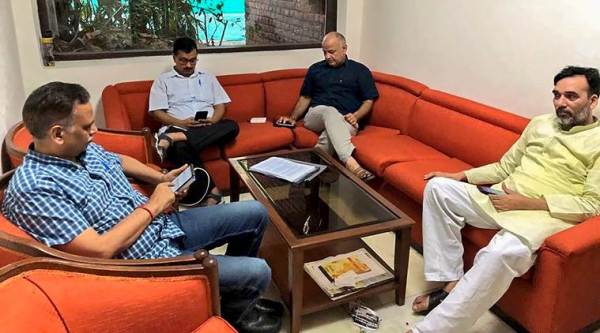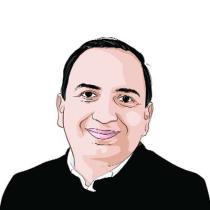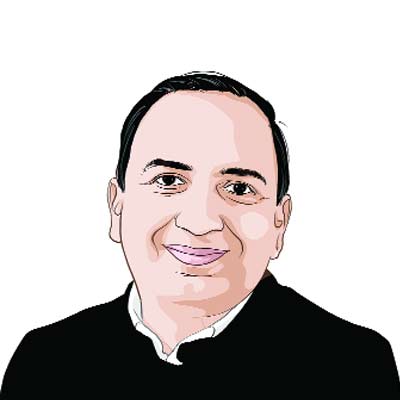A crisis in plain sight
Delhi saga showcases poison of recrimination, institutional subversion, pettiness at highest levels

Delhi Chief Minister Arvind Kejriwal with his deputy Manish Sisodia and AAP leaders Satyendra Kumar Jain and Gopal Rai at Lieutenant Governor Anil Baijal’s residence in New Delhi.
The political and constitutional crisis over the powers of the Delhi government is not just a small drama being enacted in Lutyens’ Delhi. It is an ominous sign for Indian democracy and its institutions. It is also a story of how a sordid pettiness and politics of recrimination can so easily subvert institutions. The Delhi saga is institutionalising a new culture in Indian politics.
Look at the big institutional picture. A government in Delhi is elected with an unprecedented mandate. One can concede that because of Delhi’s special status, there might be areas of ambiguity, in the allocation of powers between the Lt Governor and the chief minister. But whatever those grey areas, under no circumstances can the allocation of power be interpreted to mean that the Lt Governor can act like a tyrannical Viceroy, subverting an elected government at every step. The Lt Governor has done exactly that. The Supreme Court allowed yet another constitutional subversion by simply delaying the clarification of Delhi’s constitutional status to a point that defies logic. The Election Commission, that most hallowed of institutions, passes an order that subverts natural justice and arbitrarily disqualifies a number of AAP MLAs. The president signs without question. Fortunately, the Delhi High Court sees through the charade and restores a modicum of justice. But no one is held responsible for this attempt at institutional subversion. The most serious checks and balances in our democracy nearly failed.
The saga continues. Some AAP MLAs may have a lot to answer for. But on the surface, the patterns by which the CBI and Delhi Police seem to have been used against them, is a reminder that these days you don’t have to declare an emergency. The chief minister is made to eat humble pie through that most controversial of mechanisms: Defamation suits. The institutions of law will follow political diktats. Then the civil service comes into the picture. Then there is an incident in which the chief secretary is allegedly manhandled. But the incident seems to become a pretext to politicise the bureaucracy.
The aftermath, instead of resolving the issue, creates an even deeper crisis. The bureaucracy claims it is not on strike but is being victimised. The Delhi government claims that IAS is not carrying out its duties; it may not be on strike but is striking against it. This formal breakdown of relationship between the bureaucracy and the elected government is another first; whatever the circumstances, this was a solvable problem. The chief minister, meanwhile, goes on dharna in the LG’s office and does not get so much as a hearing. The issue, then, becomes national with four other chief ministers, rightly sensing there is a major constitutional crisis, stepping in. Such a deep institutional crisis that has subverted every institution should have shaken us up. But we reduced it to another clash of personalities.
Why this is the case is easily explained. In many ways, the sense of institutional disappointment with the AAP as a party (not with the Delhi government), the sense of being betrayed by Kejriwal is quite profound. Neither in institutional functioning, funding or even in some of its functionaries, is it seen as a party with a difference, and a consequence of that crushed idealism is such a deep cynicism that we don’t react even when there is constitutional subversion in plain sight. The sense that dharna politics cries wolf too often has blinded us to the democratic stakes here. Kejriwal did lose a lot of moral capital. The aesthetics of activism in Kejriwal are antithetical to the aura of statesmanship. But even if you concede these faults, they pale in comparison to the tyranny the central government is seeking to exercise. It would be a serious mistake to let our political views of the AAP obscure the ominous signs this episode represents.
The central government has not reconciled to the AAP’s democratic mandate. Despite facing a hostile central government and another Opposition party in the shape of the Congress, the AAP, as a government, has managed to in several areas like education show unprecedented achievement. Its governance has been far more assured than the travails of the party. This is not a party fading away. And this has led the Centre to redouble its efforts to subvert it.
There can be no other explanation of the fact that the central government is so relentlessly targeting the AAP. The Congress has not come out with flying colours either. This would have been a tremendous moment for it to rise above licking its wounds and show it can defend a matter of high principle. Besides, prudentially for 2019, the BJP, not AAP, is the appropriate target. In some ways, it needs to learn from Akhilesh Yadav and Mayawati who have put aside deep personal differences to try a new accommodation.
Second, all aspects of this crisis were easily resolvable. But it was clear from day one that the central government, with a tone of revenge set by the prime minister, wanted to precipitate a political crisis. Delhi had lived with the ambiguities of its constitutional position in part because politicians behaved like politicians, with a modicum of mutual respect and a sense of the limits they will not cross with each other. It is very clear that many of those norms of political conduct are now breaking down. Democracy is now a deeply personalised fight to the finish. In India, collective action for solving problems has always been difficult; it is about to become even more so.
Third, except for Delhi HC, almost all checks and balances that were supposed to operate, turned out to be weak: From the Supreme Court to the Election Commission, from the President of India to the CBI. Institutional design matters in democracy. But we sometimes put too much faith in design and not enough emphasis on that more nebulous but real thing: Character. So many of our best and brightest (think of the Lt Governor of Delhi, for example), abdicate their sense of judgement to the powers that be. No institutional design can, in the end, exhaust the need for public functionaries who have some stiff-backed rectitude. These functionaries are now in short supply.
One could take small comfort from the fact that Delhi’s peculiarities have something to do with the peculiar structure of Delhi. But on the other hand, if even Delhi cannot survive the poison of recrimination, institutional subversion, and sheer monumental pettiness by the highest powers that be, what will?
The writer is vice-chancellor, Ashoka University. Views are personal
For all the latest Opinion News, download Indian Express App
More From Pratap Bhanu Mehta
- Trump’s disruptionsIn the end, what he is doing may have more significance than who he is ..
- The Shangri-La momentPM Modi’s speech framed continuities, nuance in foreign policy. It needs full force of India’s example behind it..
- Where anything goesMessage of Cobrapost sting: Media subservience to power, its contempt for the citizen...








































No hay comentarios:
Publicar un comentario